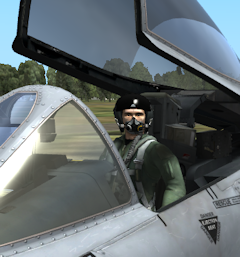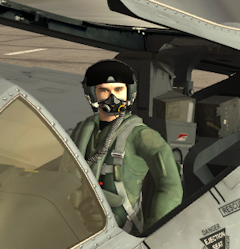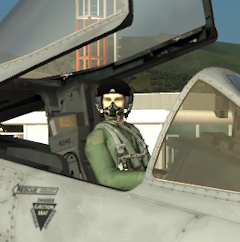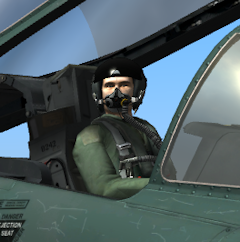-
Posts
329 -
Joined
-
Last visited
Content Type
Profiles
Forums
Events
Everything posted by Chops
-
My understanding of the throttle handle control lock, is that it functions as a friction lock, which will prevent the throttle handle from moving on its own, but still allow the pilot to move the throttle as needed.
-
I have searched the forums and the flight manual but have not found a solution to the following issue: The throttle control handle in the cockpit is constantly moving. I tried adjusting the throttle control handle lock (using my mouse to turn the handle in the cockpit) and was able to stop the movement, however, now I cannot move the throttle control handle at all. I am using a CH Fighterstick and the control wheel on the stick for throttle. Is this a beta issue or am I missing something? Thanks
-
In a jet typically, you want the aircraft to be at 50 feet crossing the runway threshold, while bringing the throttle levers smoothly back to idle power, and touching down approximately on the big white blocks (aim points) 1000 feet down the runway from the threshold. You definitely want to land within the first third of the runway.
-
I am going to offer you a refund also. Your procedures are far afield from how to operate a real jet aircraft, and have no bearing on reality. Additionally, I have found that the real world technique that Paul mentioned: - As soon as you touchdown speed brakes full open - Use the ENTIRE runway to slow to taxi speed - Use wheelbrakes as needed as you approach the end of the runway is what works bet in the sim as well.
-
Temperatures above FL240 (24,000 ft) are always negative, so what is the procedure for entering negative temps in the CDU?
-
Not sure if this will help, but in aviation terms 2000 feet = 020, and 12,000 ft = 120 for example. And as mentioned, maybe the data should be entered in typical U.S. units, since this is a U.S. aircraft.
-
Here is a video of the real thing - http://www.youtube.com/watch?feature=player_embedded&v=HCYmyxRCSMk
-
Check this link, it has been pretty well covered - http://forums.eagle.ru/showthread.php?t=81722
-
-
Just a side note - for what its worth. In a real jet you do not want to add back pressure on the stick until you reach rotation speed (Vr). Doing so will increase your takeoff roll (added drag) and affect performance numbers. Additionally, adding back pressure on the stick prior to Vr can have adverse consequences if you lose an engine before rotation, with possibly a very bad result. I wonder if the development team can add a calibration function within the sim to fine-tune trim?
-
I have had a heck of a time trying to trim the A-10 as well. I have a CH Products Fighterstick USB, and whenever I use one click of my trim switch, I get pitch changes of 5 degrees or more sometimes. I have done everything I can think of to calibrate my Fighterstick both in and out of the sim, but no luck. I have flown a number of real aircraft including multi-engine jets and none of them behave this way, of course. So, I am guessing that my hardware is faulty. The Fighterstick is a number of years old.
-
Those map icons represent Non Directional Beacons (NDB), Outer Markers, and Middle Markers. NDB's are ground-based navigation aids that are tracked by tuning in the Automatic Direction Finder (ADF) in the cockpit with the appropriate frequency as listed on the map. Outer Markers and Inner Markers are associated with an Instrument Landing System (ILS). I have not figured out how to use the instrumentation in the DCS A-10C cockpit to track an NDB. I assume that Bearing Pointer 2 on the HSI can be used, but could use some guidance on this from some of the A-10C resident experts.
-
I will add my virtual voice to the big Nevada group hug. Thanks Matt, looking forward to flying out of Nellis!
-
Rule of Thumb - you want to be at 50' AGL as you cross (fly over) the Runway Threshold while simultaneously bringing the throttles to idle. By 5 miles out from the runway you should be on speed (Vref), and fully configured for a stable approach. Carrying extra speed will result in significantly more runway used.
-
All for it. This would be very helpful.
-
Hey Matt, I would like to see how you trim the A-10C for various situations and how your aircraft reacts. Please indicate how you have trim mapped to your joystick as well, and calibrated if possible. I know how to trim a real aircraft, but the DCS A-10C is proving to be a bit more challenging. Thank you.
-
Really?? Wow, thanks for the deep and helpful observation. The way trim works in the sim does not make sense from my perspective as a pilot. There is way to much movement around the lateral axis of the aircraft when using Nose-Up or Nose-Down trim. This makes it very difficult to get the aircraft stabilized, and sort of defeats the whole purpose. This very well may be how trim works in the real A-10C, but it seems like a design flaw, especially since the airplane has such a rudimentary autopilot system. Of course, I would like to hear from an A-10C pilot regarding this issue. Are other sim pilots experiencing this problem? I am wondering if it has something to do with my hardware setup, and if there is a way to adjust or fine-tune the trim within the sim?
-
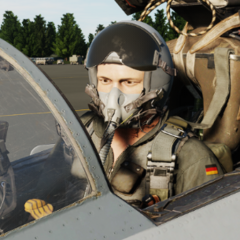
Fly heading 232 for 35, qfe 29.............
Chops replied to bloomstomb's topic in DCS: A-10C Warthog
In the U.S. civilian jets fly traffic patterns at 1500 ft. Above Ground Level (AGL). Small aircraft, Cessna's, Piper's, piston-driven fly the traffic pattern at 1000 ft AGL. When I am flying a traffic pattern in the sim, I make a note of the field elevation and then add 1500 ft to it, and fly the pattern at that altitude. This applies to Visual Flight Rules (VFR) not instrument conditions (IFR). If you are in the weather, you will be flying your filed flight plan and then an instrument approach into your landing airport. Often you will get vectors from Air Traffic Control to the final approach course. If your altimiter is set correctly, it should be reading approximately the same altitude as the field elevation while on the ramp. In fact if you don't know the current local altimeter setting at your airport you can set field elevation in your altimeter. -
One thing that I have noticed while trimming the DCS A-10 is that the trim inputs are excessive or "course". One click of the trim button/switch results in quite an attitude change. The real aircraft that I have flown do not behave that way, and I have flown everything from piper cadets to corporate jets. One click of the trim button should result in much less movement. Wondering if there is a way to fine-tune trim within the sim?
-
Just refering to page 481 in the Manual "The trim switch is used to move the control stick to a new "neutral "position. For example: if the nose wants to raise, you can input some nose down trim that will move the stick forward to a new neutral position." This is not accurate, and gives the wrong impression of how trim works.
-
The way trim is used in a real aircraft is as follows: Use the flight controls and power settings to put the aircraft into the orientation that you want. For example - level flight at 10,000 ft and 250 kts. Then use trim to relieve any control pressure that you feel. So if you find that you need forward pressure on the stick to maintain 10,000 ft at 250 kts, use nose-down trim to relieve that pressure while using the flight controls to maintain 10,000 ft. Once the aircraft is trimmed correctly you can take your hands off the flight controls and the aircraft will maintain the attitude and altitude that you have set. Trim should be used often. In a real aircraft you do not want to constantly have to apply control pressure to the stick (or yoke). It can be fatiguing and distracting. An aircraft can be trimmed in level flight, a bank, a climb, or a descent, or a combination of these. Do not "fly" with trim. Don't use trim to change the aircrafts attitude. Use the flight controls to change the attitude, and then trim to relieve any flight control pressure for hands-free flying. Whenever you change aircraft speed or orientation, you need to re-trim. The DCS A-10C Manual is not correct in the way they describe trimming.
-
Nice! Please post the links to the documents. I was unable to find the 9-line and the checklists. Thanks.
-
Turn on the 4 Fuel Pump switches located on the left console
-
I have an ASUS EAH 5770 1GB and DCS A-10C seems to run fine with it.
-
Thank you Matt for the information. In the future, will you please post this type of information as well as information on Beta releases in the Announcements Section so that it is easier to find?



